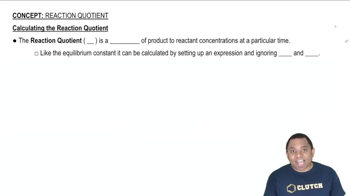Consider the following equilibrium: 2 H2(g) + S2(g) ⇌ 2 H2S(g) Kc = 1.08 × 107 at 700°C (b) Does the equilibrium mixture contain mostly H2 and S2 or mostly H2S?
Ch.15 - Chemical Equilibrium
Chapter 15, Problem 25a,b
At 1000 K, 𝐾𝑝 = 1.85 for the reaction SO2(𝑔) + 1/2 O2(𝑔) ⇌ SO3(𝑔) (a) What is the value of Kp for the reaction SO3(𝑔) ⇌ SO2(𝑔) + 1/2 O2(𝑔)? (b) What is the value of Kp for the reaction 2 SO2(𝑔) + O2(𝑔) ⇌ 2 SO3(𝑔)?
 Verified step by step guidance
Verified step by step guidance1
To find the value of Kp for the reverse reaction SO3(g) ⇌ SO2(g) + 1/2 O2(g), we need to take the reciprocal of the given Kp for the forward reaction. This is because the equilibrium constant for a reverse reaction is the inverse of the equilibrium constant for the forward reaction.
For part (a), calculate the reciprocal of Kp: Kp(reverse) = 1 / Kp(forward). Substitute the given Kp value of 1.85 into this expression.
For part (b), we need to determine the Kp for the reaction 2 SO2(g) + O2(g) ⇌ 2 SO3(g). Notice that this reaction is the original reaction multiplied by 2.
When a chemical equation is multiplied by a factor, the equilibrium constant is raised to the power of that factor. Therefore, for the reaction 2 SO2(g) + O2(g) ⇌ 2 SO3(g), Kp(new) = (Kp(original))^2.
Substitute the given Kp value of 1.85 into the expression for Kp(new) to find the equilibrium constant for the reaction 2 SO2(g) + O2(g) ⇌ 2 SO3(g).
Key Concepts
Here are the essential concepts you must grasp in order to answer the question correctly.
Equilibrium Constant (Kp)
The equilibrium constant, Kp, is a numerical value that expresses the ratio of the concentrations of products to reactants at equilibrium for a given reaction at a specific temperature. It is calculated using the partial pressures of gases involved in the reaction. A larger Kp value indicates a greater concentration of products at equilibrium, while a smaller value suggests a higher concentration of reactants.
Recommended video:
Guided course

Equilibrium Constant Expressions
Reaction Quotient (Q)
The reaction quotient, Q, is a measure of the relative amounts of products and reactants present in a reaction at any point in time, not necessarily at equilibrium. It is calculated in the same way as Kp but uses the current concentrations or partial pressures. Comparing Q to Kp helps predict the direction in which a reaction will proceed to reach equilibrium.
Recommended video:
Guided course

Reaction Quotient Q
Le Chatelier's Principle
Le Chatelier's Principle states that if a dynamic equilibrium is disturbed by changing the conditions, the system will adjust itself to counteract the change and restore a new equilibrium. This principle is crucial for understanding how changes in concentration, pressure, or temperature affect the position of equilibrium and the values of Kp for related reactions.
Recommended video:
Guided course

Le Chatelier's Principle
Related Practice
Textbook Question
Textbook Question
Consider the following equilibrium: 2 H2(g) + S2(g) ⇌ 2 H2S(g) Kc = 1.08 × 107 at 700°C (c) Calculate the value of 𝐾𝑐 if you rewrote the equation H2(g) + 1/2 S2(g) ⇌ H2S(g)
Textbook Question
At 1000 K, 𝐾𝑝 = 1.85 for the reaction SO2(𝑔) + 12 O2(𝑔) ⇌ SO3(𝑔) (c) What is the value of 𝐾𝑐 for the reaction in part (b)?
Textbook Question
Consider the following equilibrium, for which 𝐾𝑝 = 0.0752 at 480°C: 2 Cl2(𝑔) + 2 H2O(𝑔) ⇌ 4 HCl(𝑔) + O2(𝑔) (a) What is the value of 𝐾𝑝 for the reaction 4 HCl(𝑔) + O2(𝑔) ⇌ 2 Cl2(𝑔) + 2 H2O(𝑔)?
Textbook Question
Consider the following equilibrium, for which Kp = 0.0752 at 480°C: 2 Cl2(g) + 2 H2O(g) ⇌ 4 HCl(g) + O2(g) (b) What is the value of Kp for the reaction Cl2(g) + H2O(g) ⇌ 2 HCl(g) + 1/2 O2(g)?
